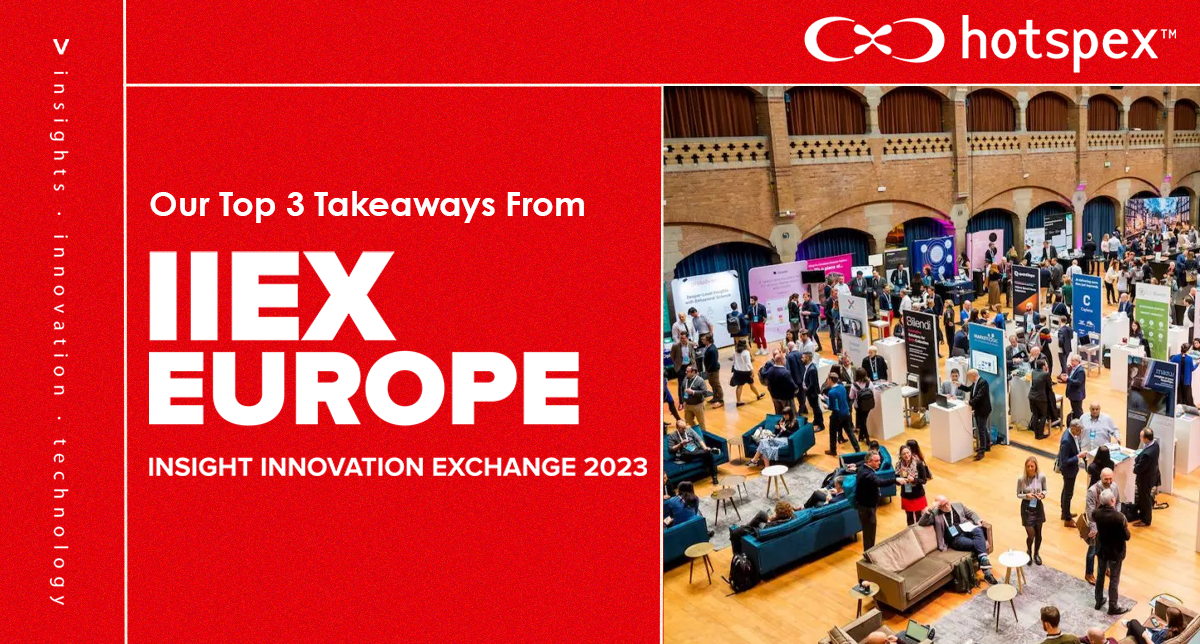
Our Top 3 Takeaways from IIEX Europe 2023
Wow! Last June, we were in Amsterdam for this conference, and it was outstanding to see the progress of our industry in only nine months. It will be fascinating to see how much evolves ahead of the next conference, IIEX North America in Austin, where Gera Nevolovich will be talking with Michael Lancor, VP of Analytics & Insights Capability Building at P&G.
1 – Maximizing AI
It was fantastic to demo our integrated AI platform, which is helping our clients access consumer insights faster. From a raw data file to a client-ready deliverable, the #generativeai based platform provides a written narrative summarising the findings, #datavisualization in a slide deck with a comprehensive appendix. All this in less than 10 minutes, which could previously take up to 10 days. What used to take up to two weeks of a multifunctional team’s time now takes a few clicks.
This impact is profound: significant time-to-value acceleration and freeing up our analysts to spend more time on actual learning value creation for our clients. And this is just the beginning.
Whilst we do not align with the provocative yet compelling headline from Steve Phillips at Zappi of ‘Why GPT-3 will kill the researcher?’, we feel AI-based programs will ultimately allow us to focus more on our customers & free more time for creative human thinking, leaving the repetitive to the machine.
2 – Don’t leave the consumer behind!
With artificial intelligence recasting how we seek information, it can be exciting and terrifying in equal measure.
Sometimes what we see from the industry, particularly how some approach technological advancements, raises the question of whether we are all on the same page - Have we left the consumer behind? Tiphany Yokas (Mondelēz International), Katja Maggio (JDE Peet’s) and Nadia Morozova (EY) helped unpack this question with Gera Nevolovich (Hotspex). Learn more here.
The antidote to CHATGPT and the researcher’s predicted death penalty notice was perfectly balanced with “Why the Qual Boom?” highlighting the need for rigour & a human touch in our approach. Debbi Hart (Fosta) and Mike Stevens (Insight Platforms) explained how up to 88% of digital ad clicks are fraudulent, and ad fraud is predicted to be worth approximately $150bn by 2025. Can you trust what the algorithms tell you without the consumer voice in the room?
3 – Is it time for your communication strategy to evolve?
The closing keynote by Ray Poynter (The Future Place) and Nikki Lavoie (Savanta), chaired by Karen Lynch (Greenbook), was a powerful call to arms for our industry. To survive, agencies will need to focus on innovation. Yet fundamental questions of Quant vs Qual, which were asked in the 1920s, will continue to be asked in the 2020s. The panel predicted a rise in qual questioning, as language processing will allow studies to go further than the one-question follow-up, i.e. ‘Why did you purchase?’ to be replaced by a two-way conversation allowing deeper probes.
At Hotspex, we have developed a 2-stage, tailored-suit Machine Learning algorithm to determine the maximum likelihood and prescriptive drivers of Purchase Probability from ad campaigns on digital & social, leveraging the best technology into one cost-effective solution. To supercharge your comms solution, the Hotspex platform now includes behavioural YouTube & TikTok integration, emotional measurement of the brand, System 1 implicit associations, qualitative video reactions, scene-by-scene prioritisation, predictive modelling & integration into media spend.
_
Hotspex uses behavioural observation and implicit psychometrics to uncover learnings undetectable to traditional claimed/direct research. To learn more, contact us here to discuss how we can help with your immediate brand growth and research challenges.




